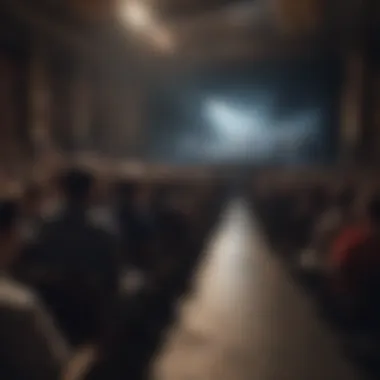Unveiling the Art of Magic: Techniques and History


Intro
Magic has fascinated humanity for centuries. In every culture, there have been masters of illusion, captivating audiences with feats that seem impossible. Understanding magic involves not only learning tricks but also appreciating their historical and cultural significance. Magic combines art, psychology, and technique to create experiences that engage both the performer and the audience deeply.
This article explores the best magic tricks by examining their techniques and the context surrounding them. The analysis goes beyond surface-level performance and delves into how tricks have evolved over time. We will also look at the psychological principles that underpin these illusions, enhancing our understanding of how they affect spectators.
By dissecting various well-known tricks, this work aims to provide enthusiasts, researchers, and educators with a comprehensive guide. Each section will hold insights relevant for those interested in the art of magic, as well as the broader implications of performance as a cultural phenomenon.
Prelims to Magic
The realm of magic captivates audiences across the globe, transcending mere entertainment. Magic, as a practice, explores the intricate relationship between illusion and reality. It is essential to understand the foundations of magic as an art form and its historical context to appreciate its depth fully. This section lays the groundwork for an exploration of the best magic tricks, emphasizing both its technical prowess and the impact it has had on culture and society.
Definition of Magic
Magic can be defined as the art of creating illusions that provoke amazement and wonder. This art form involves spectacular feats and clever techniques that manipulate perception. At its core, magic aims to evoke a sense of mystery, where the ordinary becomes extraordinary. It involves not just sleight of hand but also the ability to engage the audience's imagination and challenge their understanding of reality. The purpose is to create a shared experience that leaves a lasting impression.
The Evolution of Magic
The history of magic is rich and varied. It spans back to ancient civilizations, where rituals and spiritual practices often invoked elements of magic. Ancient Egyptians and Greeks incorporated magical performances into their ceremonies. Over centuries, magic evolved through various cultural influences. In the Middle Ages, court magicians entertained royals, using their art to gain favor. By the 19th century, with the advent of stage magic, performers like Jean Eugène Robert-Houdin revolutionized the craft. They introduced theatrical elements that turned magic into a respected performance art. Each era contributed distinct techniques and styles, reflecting the society that produced them.
Cultural Significance
Magic holds a unique position in cultural discourse. It often serves as a microcosm of wider societal values and beliefs. In many cultures, magic is intertwined with folklore and myth, highlighting the human desire to understand the unknown. Furthermore, magic can act as a channel for social commentary, allowing performers to challenge norms and provoke thought. From street performers in urban settings to grand theatrical presentations, magic communicates universal themes. Its significance stretches beyond entertainment, influencing literature, film, and art. As a study of magic unfolds, it becomes evident that this art form reflects human curiosity and the quest for understanding.
Key Components of Magic Tricks
In the realm of magic, several elements form the foundation of all tricks and performances. Understanding these components is paramount for both magicians and audiences. These elements not only contribute to the effectiveness of a performance but also shape the experience of the viewers. A magician's ability to weave these components together determines the success of their act. Without a solid grasp of the basic techniques, the audience might lose interest or fail to appreciate the skill involved. This section delves into the essential components that form the backbone of magical performances, examining their significance and applications.
Illusion and Perception
Illusion is the core of magic. It creates a sense of disbelief that captivates audiences. A magician must craft an experience that deceives perception effectively. The challenge lies in manipulating what people see, feel, and comprehend. For instance, a classic illusion like the sawing a woman in half depends on the audience's perception of reality. When executed correctly, the performer skillfully guides the audience to see one thing while the underlying mechanics remain hidden.
Moreover, illusions can vary widely in complexity. Simple tricks, like a disappearing coin, rely on basic sleight of hand, while grand illusions often employ intricate setups and stagecraft. Each trick's success hinges on the magician's ability to make the impossible appear credible, thus invoking a sense of wonder and amazement.
Misdirection Techniques
Misdirection serves as a vital technique in magic performance. It's the art of focusing the audience's attention away from the method behind a trick. With a skillful display or a well-timed distraction, a magician can execute an illusion without the audience noticing. This keeps the secrets hidden and the magic alive.
There are several methods magicians use to misdirect:
- Physical misdirection: Engaging audiences with hand gestures or movements can draw attention to one hand while the other performs the secret action.
- Verbal misdirection: A well-timed joke or a surprising statement can divert attention at crucial moments.
- Emotional misdirection: Playing on audience emotions can also effectively divert focus. A magician may create suspense through storytelling, leading the audience to concentrate on the narrative rather than the trick’s mechanics.


Misdirection elevates a simple performance into a remarkable experience. It not only entertains but also immerses spectators in the illusion.
Psychological Principles in Magic
Psychological principles play an essential role in the effectiveness of magic. Understanding how the brain processes information allows magicians to craft experiences that resonate deeply with audiences. Some key psychological components include:
- Cognitive biases: Magicians exploit various cognitive biases to enhance the illusion. For instance, the illusion of control can make spectators believe they have influence over the outcome when in reality, the magician directs everything.
- Expectation management: A crucial aspect is managing audience expectations. When magicians foreshadow actions or outcomes, they create a build-up that heightens anticipation.
- Memory manipulation: Magicians can manipulate memory recall. The goal is to create a setting where the audience misremembers key details, making the trick seem even more surprising.
Enhancing performances through psychology not only makes the acts captivating but also fosters a deeper connection between the magician and the audience. This connection nurtures the overall experience and leaves a lasting impression.
The art of magic transcends mere illusion. It intertwines skill, perception, and psychological insight to create experiences that amaze and transform how audiences see reality.
Classic Magic Tricks
Classic magic tricks hold a significant place in the domain of illusion and performance. These tricks have stood the test of time, captivating audiences across generations. Their importance in this article lies not only in their foundational techniques but also in their cultural and historical resonance. By examining classic tricks, we can better appreciate the art of magic and its evolution over the years.
Elements of Classic Magic
Classic magic tricks often rely on a mix of simple mechanics and complex presentation. Key elements include:
- Illusion: Each trick aims to deceive the audience's senses, leading to a perceived impossibility.
- Execution: Skillful execution is crucial, often requiring extensive practice to perfect the timing and delivery.
- Showmanship: The magician’s personality and performance style greatly influence the trick’s impact, transforming a simple act into an unforgettable experience.
Benefits and Considerations
Engaging with classic magic tricks provides several benefits. It enhances our understanding of psychological principles at play within these performances. Moreover, classic tricks often serve as the building blocks for more advanced illusions. It is essential to recognize that the artistry and presentation are just as vital as the technique. Practitioners must balance the mechanics of the tricks with audience engagement to create a truly memorable experience.
The Vanishing Act
The vanishing act is perhaps one of the most iconic forms of magic. This trick captures the audience's imagination as they witness an object or person seemingly disappear from sight. Its historical significance stems from its ancient roots, appearing in various cultures with different interpretations.
Mechanics of the Trick:
Through clever misdirection and the use of props like trap doors or hidden compartments, performers create the illusion of disappearance. The execution of a vanishing trick relies heavily on timing. An audience’s focus must be directed to one point while the actual action occurs elsewhere.
Cultural References:
Vanishing acts have appeared in literature and film, reinforcing their significance in popular culture. From traditional stage performances to street magic, the allure of the vanishing act continues to fascinate.
The Levitation Trick
Levitation tricks represent another staple of magic. These acts evoke awe as they suggest the defiance of gravity, leading audiences to question reality itself.
Origins and Development:
Historically, levitation tricks date back centuries. Early records from various cultures show that they were often tied to spiritual beliefs, with performers appearing as mystics or prophets.
Implementation:
Modern levitation tricks often utilize wires, platforms, or illusions created by staging. The technique is not merely a demonstration of physical prowess but a display of theatrical skill. The challenge lies in creating a seamless experience that leaves the audience in awe.
Card Tricks and Their Variations
Card tricks form a diverse subset of classic magic, appealing to both practitioners and audiences. The simplicity of cards belies the complexity of the tricks that can be performed with them.


Types of Card Tricks:
Card tricks vary widely, including:
- Forcing: Influencing a spectator to select a predetermined card while making it appear random.
- Shuffling: Creating the illusion of a mixed deck to prepare for a surprise result.
- Prediction: Revealing a previously stated card that a participant selects, demonstrating psychological insight.
Popularity and Impact:
The allure of card tricks often stems from their accessibility. Many novice magicians start with card tricks due to the minimal required props. This form of magic fosters community engagement and sharing of techniques through various platforms, enhancing its cultural relevance.
"Classic tricks are the foundation upon which modern magic builds. They offer insight into the art while preserving the mystery that keeps audiences enchanted."
Famous Magicians and Their Tricks
In the study of magic, understanding the contributions of famous magicians offers significant insight into the evolution of performances and techniques. Each magician not only showcased their unique skills but also pushed the boundaries of what was possible in magic. Their tricks often reflect cultural trends and advancements in technology at their respective times.
The tricks performed by these magicians become a part of their legacy and illustrate the progression of magical techniques from mere illusions to complex psychological engagements.
Famous magicians help illuminate many elements of magic's richness. With deep characterizations, innovative approaches, and polished performances, they engage audiences at a level beyond simple entertainment. Each historic figure plays a role in setting standards, inspiring new generations, and creating a rich tradition of performance art.
David Copperfield
David Copperfield is one of the most recognized names in magic today. He has managed to combine traditional magic tricks with spectacular theatrical presentations. His works often blur the lines between illusion and reality, creating an immersive experience for audiences.
Born in 1956, Copperfield began performing at a young age and quickly achieved fame and success. His most notable tricks include the
Modern Developments in Magic
Modern magic has undergone significant transformations, influenced by advancements in technology and changing societal landscapes. These developments are not merely superficial alterations; they redefine the essence of how magic is practiced and perceived. Understanding modern developments is essential to grasp the current environment in which magicians operate and the ways they've adapted their craft to remain relevant. The essence of this section lies in examining the innovative techniques, the social dynamics at play, and the challenges presented by virtual interactions.
Technology in Magic
Technology has revolutionized the world of magic, introducing tools that augment traditional tricks. From apps that assist in card tricks to sophisticated lighting and sound effects, tech innovations allow magicians to refine their performances. Here's how different technologies have impacted magic:
- Digital Illusions: Software that creates illusions on screens can engage audiences in new ways, often merging art and technology.
- Remote-Controlled Gadgets: Devices that aid in illusion, such as drones, enhance the complexity of tricks, making performances more engaging.
- Augmented and Virtual Reality: These technologies can create immersive experiences. For instance, some performances incorporate VR to involve audiences in ways never seen before.
These advancements blur the lines between reality and illusion, enabling magicians to craft experiences that were previously impossible.
Social Media Influence
The rise of social media has dramatically altered how magic is shared and viewed. Platforms like Facebook and Reddit facilitate the rapid spread of magic tricks and performances, while also providing a space for critiques and discussions. Several factors contribute to this shift:
- Increased Accessibility: Magicians can now showcase their talent to a global audience, bypassing traditional gatekeepers. This access encourages creativity and innovation.
- Viral Trends: Short, engaging videos can quickly go viral, leading to fame for many. This phenomenon influences what magic is currently popular.
- Audience Interaction: Social media allows real-time feedback, enabling magicians to adjust their performances according to audience reactions and preferences.
Overall, social media plays a dual role: it democratizes magic while simultaneously challenging magicians to stay relevant.


The Virtual Performance Challenge
With the rise of online platforms, virtual performances have become more prevalent. They introduce unique challenges and opportunities not present in traditional magic. Here are key aspects to consider:
- Engagement: Virtual audiences can be harder to engage due to physical distance. Performing in front of a screen rather than in-person requires different skills, often centered around maintaining attention over digital mediums.
- Innovation in Presentation: Magicians must leverage online tools like live streaming and interactive elements to effectively engage viewers. This could involve using chat features or integrating audience choices into the performance.
- Technical Issues: Dependence on technology for virtual performances means that technical difficulties can disrupt the flow, requiring performers to be exceptionally adaptable.
As magicians navigate this evolving landscape, they must balance tradition with innovation, ensuring their art form remains vibrant and resonant in a digital age.
"The future of magic lies in its ability to adapt to technological advancements while remaining true to its essence—a testament to the art, creativity, and human connection that define it."
These modern developments in magic reflect a dynamic interplay between tradition and innovation, showcasing how magicians thrive in an ever-changing world.
The Ethics of Magic
The subject of ethics in magic is often underexplored, yet it is essential to the integrity of the art form. Ethical considerations in magic not only define how magicians interact with their audience but also shape public perception of magic as an entertainment medium. For a performer, maintaining trust is crucial, as the effectiveness of illusions relies significantly on audience belief. When discussing the ethics of magic, two major facets emerge: the code of conduct among practitioners and the importance of respecting audience perception.
The Code of Conduct
The code of conduct within the magic community serves as a guiding principle for magicians. This informal set of rules and standards helps maintain professionalism and honor among performers. Here are some key aspects:
- Sharing Techniques: While it is natural to want to share knowledge, the unwritten code emphasizes keeping specific techniques secret to preserve the magic's mystique.
- Crediting Others: Acknowledgment of fellow magicians’ work is essential. It is considered unethical to take credit for someone else's trick or concept.
- Respecting Peers: Every magician has their unique style and methods, which should be respected. Avoiding disparagement creates a healthy community where creativity can flourish.
Adhering to this code not only builds camaraderie among magicians but also elevates the art form in the eyes of the public. It promotes an environment where new talent can emerge and innovate, fostering growth in the field.
Respecting Audience Perception
Respecting audience perception is crucial for the sustenance of magic as a form of entertainment. When magicians perform, they engage in a contract of sorts, where the audience agrees to suspend disbelief. However, several elements must be considered:
- Consent and Awareness: Magicians should ensure that their performances are consensual. The audience should be aware that they are witnessing a magical illusion, rather than being misled into believing in supernatural abilities.
- Emotional Safety: Some tricks may evoke fear or anxiety. It is important for magicians to assess their audience's emotional state and adjust their performances accordingly.
- Cultural Sensitivity: Magicians must also be cognizant of cultural backgrounds and beliefs. Tricks that may be amusing or harmless in one culture can be offensive or misunderstood in another.
In summary, the ethics of magic embodies respect for both the craft and the audience. By maintaining high ethical standards, magicians enrich the performance experience and affirm the art's credibility.
"Magic is an illusion, but the emotions it evokes are real."
Through mindful practices, the art of magic can continue to captivate minds while upholding moral considerations.
Closure
The realm of magic possesses an enduring significance that extends beyond mere entertainment. This section will explore the critical elements that contribute to the ongoing allure of magic and its likely pathways for evolution in the future.
The Enduring Appeal of Magic
Magic captivates audiences by challenging their expectations. Its intrinsic ability to blend reality with illusion engages the minds of viewers, often inspiring wonder. This phenomenon is largely grounded in psychological principles and the human love for mystery. The experience is heightened when spectators participate, creating a personal connection to the performance. Famous magicians such as Harry Houdini and David Copperfield have expertly harnessed this personal engagement to create memorable experiences. The charm of magic lies in its surprises and the emotional responses it evokes. This relationship with the audience also fosters loyalty. People return to magic shows not only for the spectacle but for the consistent thrill that comes with experiencing something extraordinary.
Future Directions in Magic
As we look ahead, the future of magic is likely to embrace technology more deeply. Innovations in augmented reality and virtual reality will provide new venues for performing illusions. Social media platforms are reshaping how magicians showcase their talent, allowing for instantaneous feedback and broader audience reach. This digital transition will give rise to new forms of magic that combine traditional techniques with modern tech. However, as the landscape changes, ethical considerations remain paramount. Respecting the audience's perception and maintaining the essence of magic will be crucial. The balance between innovation and tradition will determine the future trajectory of magic as an art form.















